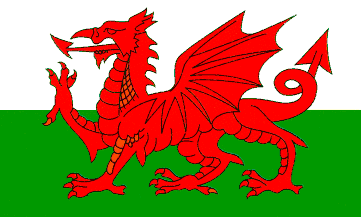 |
 |
deel 1 |
Friday 17 May 2024
We travel from Rotterdam Central Station to London with the high-speed train Eurostar. We travel in Standard Premier class. The seats are spacious and we depart at 7.28 a.m. from Rotterdam. We get a breakfast in the form of a banana roll, orange juice, coffee or tea. The first stop is Brussels South, where the train stops for 20 minutes. Then on to Lille, from where after a short stop, we carry on to London, through the Channel Tunnel. We arrive at St Pancrass station in London at 9.57am local time. We walk to tube station and take the Circle line to Paddington station. We were supposed to take the 11.16 train to Cardiff, but it's cancelled. The next train is at 11.48. Obviously, we do not have a seat reservation anymore, but there is enough space in 1st class of the train. However, there is little time between the announcement of the departure track and the departure time. But it all works out. We are in 1st class and are served unlimited drinks and snacks if we wish. After 2 hours we arrive at Cardiff Central at 13.39. From there it's a few minutes walk to the Royal Hotel.
In the evening we have dinner in the Potted Pig , which is located in the basement of a former bank building.
Weather: in Cardiff 21° and sunny.
Saturday18 May 2024
The next
day we start at the Castle Arcade, one of the many
19th  century
shopping
arcades
in Cardiff city centre. We drink coffee at Baker Café. Then we go to Cardiff
Castle.
Its history dates back to the Romans, but it The oldest surviving part
is the Norman keep. Around it is a English wall. Main attraction are the 19th
century of the Marquises of Bute. This family developed Cardiff as a
port and industrial city and owned many coal mines in the area. The
3rd Marquis was one of the richest people in the world. The family was
of Scottish origin and only stayed in the castle for 7 weeks a year.
Nevertheless, the castle is very expensively designed and fully
equipped. There are all kinds of state rooms, where you can see that
money was not a problem. The Arab room, the Roman Room, banquet room,
etc etc. This Rooms can only be visited with a guide.
century
shopping
arcades
in Cardiff city centre. We drink coffee at Baker Café. Then we go to Cardiff
Castle.
Its history dates back to the Romans, but it The oldest surviving part
is the Norman keep. Around it is a English wall. Main attraction are the 19th
century of the Marquises of Bute. This family developed Cardiff as a
port and industrial city and owned many coal mines in the area. The
3rd Marquis was one of the richest people in the world. The family was
of Scottish origin and only stayed in the castle for 7 weeks a year.
Nevertheless, the castle is very expensively designed and fully
equipped. There are all kinds of state rooms, where you can see that
money was not a problem. The Arab room, the Roman Room, banquet room,
etc etc. This Rooms can only be visited with a guide.
From the
castle we walk via the Royal Arcade and the Morgan Arcade to the Cardiff
Market. This is a covered market from the Victorian era. Here
vegetables, fruit, meat, fish and other foodstuffs are sold, but also
clothing and music.
We have lunch
at the Morgan Ar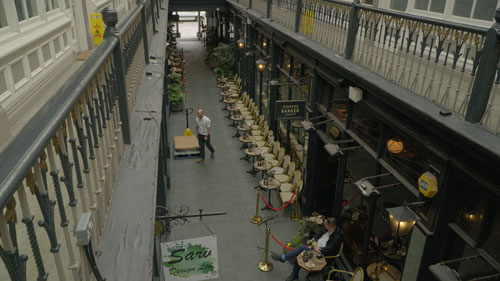 cade and at
noon we visit the Principality Stadium. This
stadium was built in 1999 for the Rugby World Cup. It is used as the
home stadium of the Welsh rugby team and In addition, as a concert
venue. The stadium has a retractable roof like the Johan Cruijff Arena
in Amsterdam. It can hold 72,500 people. We join the guided tour through the
stadium and see the stands, the VIP lounges, the changing rooms and
the press room. Rugby is the No. 1 sport in Wales. More important than
football, although in recent years there has been more success with
that. The stadium is also used for other events, such as pop concerts.
cade and at
noon we visit the Principality Stadium. This
stadium was built in 1999 for the Rugby World Cup. It is used as the
home stadium of the Welsh rugby team and In addition, as a concert
venue. The stadium has a retractable roof like the Johan Cruijff Arena
in Amsterdam. It can hold 72,500 people. We join the guided tour through the
stadium and see the stands, the VIP lounges, the changing rooms and
the press room. Rugby is the No. 1 sport in Wales. More important than
football, although in recent years there has been more success with
that. The stadium is also used for other events, such as pop concerts.
Weather: 20°, intermittent clouds
Zondag 19 mei 2024
Sunday morning we take the bus to Cardiff Bay, the harbour area that is Red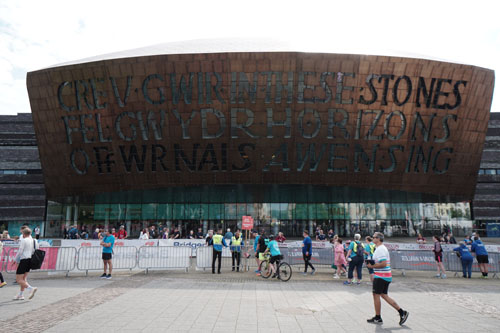 eveloped with new construction, catering and
cultural institutions. Most Notable is the Millennium Centre, the
cultural centre of the country and home to the BBC Wales National
Orchestra and Choir. There is Today a 10km run and it's very busy around
the Roald Dahl lake, named after the author who was born and baptized
here. In addition to the Millennium Centre stands the Sennedd, the Welsh
parliament, designed by Richard Rodgers. Further on is the Norwegian
Seamen's Church, where Roald Dahl was baptized in 1916. On the western
side of the Bay there are many restaurants and homes. Around half past
eleven we go back to the hotel. We have lunch again in the Royal Arcade.
In the afternoon we take the bus to Llandaf . In this village,
which is now a suburb of Cardiff, stands the cathedral of the city.
Originally a Norman church and in the course of the expanded over time.
eveloped with new construction, catering and
cultural institutions. Most Notable is the Millennium Centre, the
cultural centre of the country and home to the BBC Wales National
Orchestra and Choir. There is Today a 10km run and it's very busy around
the Roald Dahl lake, named after the author who was born and baptized
here. In addition to the Millennium Centre stands the Sennedd, the Welsh
parliament, designed by Richard Rodgers. Further on is the Norwegian
Seamen's Church, where Roald Dahl was baptized in 1916. On the western
side of the Bay there are many restaurants and homes. Around half past
eleven we go back to the hotel. We have lunch again in the Royal Arcade.
In the afternoon we take the bus to Llandaf . In this village,
which is now a suburb of Cardiff, stands the cathedral of the city.
Originally a Norman church and in the course of the expanded over time.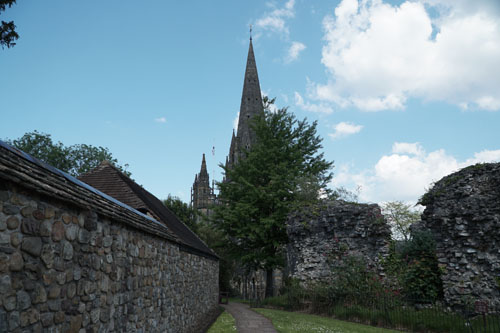 Beautiful stained glass windows. The church
choir holds a rehearsal during our visit. In the evening we have dinner
at Purple
Poppadum, an Indian restaurant outside the city centre. We close
the day off with a drink at , Mary’s the gay neighbors of our hotel.
Beautiful stained glass windows. The church
choir holds a rehearsal during our visit. In the evening we have dinner
at Purple
Poppadum, an Indian restaurant outside the city centre. We close
the day off with a drink at , Mary’s the gay neighbors of our hotel.
Weather: sunny and 22
Monday 20 May 2024
Monday we order an Uber taxi for the ride to the Hertz car rental on an
industrial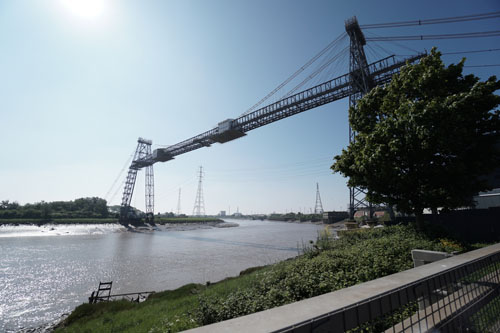 estate, about 3.5 km to the
Southwest. At Hertz we get an upgrade to a Nissan Qasquai. We had booked
a Vauxhall Astra. We drive to Newport to check out the Transporter
bridge. This is a horizontal lift over the river, which was built at the
end of the 19th century to provide the dockworkers a shorter route to
work. Unfortunately, the elevator is out of order due to renovation
work. We drive on to Tintern Abbey. This abbey was founded in
1131 by Cistercian monks, who came from Normandy. In the 14th century,
the abbey flourished, but after that it got in decline. In 1536
estate, about 3.5 km to the
Southwest. At Hertz we get an upgrade to a Nissan Qasquai. We had booked
a Vauxhall Astra. We drive to Newport to check out the Transporter
bridge. This is a horizontal lift over the river, which was built at the
end of the 19th century to provide the dockworkers a shorter route to
work. Unfortunately, the elevator is out of order due to renovation
work. We drive on to Tintern Abbey. This abbey was founded in
1131 by Cistercian monks, who came from Normandy. In the 14th century,
the abbey flourished, but after that it got in decline. In 1536 the abbey was dissolved at the order of Henry VIII. The Monks
disappeared and the abbey fell into disrepair. Luckily it was remotely
located and local residents did not have the chance to recycle stones of
the monastery. The church is still reasonably intact, with only the roof
missing. Not much remains of the cells of the monks, just the outlines.
The ruins are managed by Cadw, the Welsh Heritage Agency. We We have memberships,
so we can get in for free. Membership costs £60 per year. Next we drive
on to our B&B Ty
Helig in Brecon. In Abergavenny we make a stop for lunch.
Then we drive to Brecon. We are warmly welcomed by Christine. We explore
the village at the end of the afternoon and drink a beer at Brecon Tap.
That's where we eat later as well.
the abbey was dissolved at the order of Henry VIII. The Monks
disappeared and the abbey fell into disrepair. Luckily it was remotely
located and local residents did not have the chance to recycle stones of
the monastery. The church is still reasonably intact, with only the roof
missing. Not much remains of the cells of the monks, just the outlines.
The ruins are managed by Cadw, the Welsh Heritage Agency. We We have memberships,
so we can get in for free. Membership costs £60 per year. Next we drive
on to our B&B Ty
Helig in Brecon. In Abergavenny we make a stop for lunch.
Then we drive to Brecon. We are warmly welcomed by Christine. We explore
the village at the end of the afternoon and drink a beer at Brecon Tap.
That's where we eat later as well.
Weather: sunny 20°
Tuesday, 21 May 2024
We passed on our wishes for breakfast yesterday and are at our beck and
call this morning. Erik takes scrambled eggs and salmon and a sausage. I
cereal and the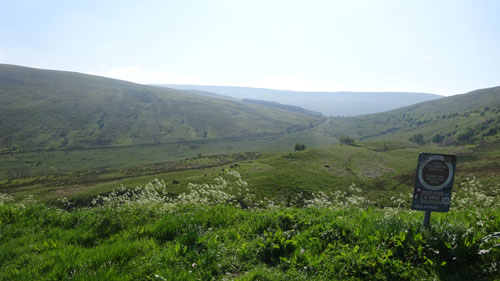 n salmon and
toast, tomato and mushrooms. Due to a misunderstanding in the kitchen, I
also get egg, but I donate it to Erik in exchange for some salmon. After
breakfast we go for coffee in the village. After coffee we drive along
the tourist information first and then south into the National Park Brecon Beacons. The intention
is to go hiking to the waterfalls in the park, but the navigation lets
us down, so we end up completely wrong. We were given a postal code as
our address, but the navigation does not know it. When we find out, it
goes wrong again. We have lunch at a pub in Ponsticill. Eventually it
works out, but it is already 2 p.m. when we find a parking lot from
which you can walk to the falls. I walk to the Sgwd Clun-gwyn, just a
15-minute walk from the parking lot. I could have walked to another
waterfall, but
n salmon and
toast, tomato and mushrooms. Due to a misunderstanding in the kitchen, I
also get egg, but I donate it to Erik in exchange for some salmon. After
breakfast we go for coffee in the village. After coffee we drive along
the tourist information first and then south into the National Park Brecon Beacons. The intention
is to go hiking to the waterfalls in the park, but the navigation lets
us down, so we end up completely wrong. We were given a postal code as
our address, but the navigation does not know it. When we find out, it
goes wrong again. We have lunch at a pub in Ponsticill. Eventually it
works out, but it is already 2 p.m. when we find a parking lot from
which you can walk to the falls. I walk to the Sgwd Clun-gwyn, just a
15-minute walk from the parking lot. I could have walked to another
waterfall, but 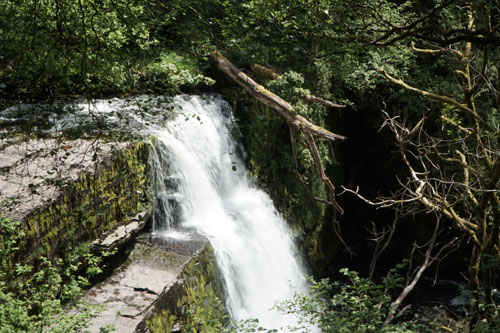 I leave it at that. Then we visit
Brecon Cathedral. Its history goes back to 1093, but what we see now is
mostly Gothic in style.
I leave it at that. Then we visit
Brecon Cathedral. Its history goes back to 1093, but what we see now is
mostly Gothic in style.
In the evening we have dinner at Thai's restaurant, Changtai.
Weather: slightly cloudy and lots of sunshine. 19 degrees
Wednesday, 22 May 2024
After breakfast and coffee at Coffee
#1, we set out for Pembrokeshire. The drive on the A40 takes about
2 hours. This is followed by a stretch of very narrow roads that
eventually lead to our destination. We arrive at the Airbnb cottage in Clarbeston Road a little after
11 am. The house is so remote that we don't even have reception on our
cell phone. Fortunately, there is cable and Internet with WiFi. Owner
Sue is not there to welcome us, but the door is open and we can let
ourselves in. We put things inside and make a shopping list. We drive to
Haverford West, where we shop at the Morisson supermarket. We also eat
there in the cafeteria. Nothing special, but convenient.
Weather: heavily cloudy, a little drizzle, but clearings in the
afternoon. 16 degrees.
Thursday, May 23, 2024
Thursday we drive to Laugharne, half an hour southeast of
Clarbeston Road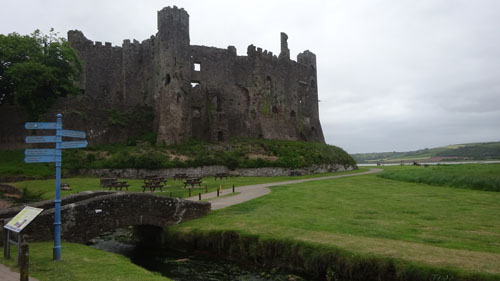 . The fishing village has a
castle dating back to the 12th century. It was fortified by the Normans,
but eventually severely damaged during the English Civil War in the 17th
century. It has been a ruin ever since. The village is more famous for
Welsh poet Dylan Thomas (1914-53), who lived here from 1949 to
1953. He lived in Sea View House and wrote his poems and prose in a boat
house on the waterfront. Both buildings have been preserved and the
"Writing Shed" is furnished as it
. The fishing village has a
castle dating back to the 12th century. It was fortified by the Normans,
but eventually severely damaged during the English Civil War in the 17th
century. It has been a ruin ever since. The village is more famous for
Welsh poet Dylan Thomas (1914-53), who lived here from 1949 to
1953. He lived in Sea View House and wrote his poems and prose in a boat
house on the waterfront. Both buildings have been preserved and the
"Writing Shed" is furnished as it 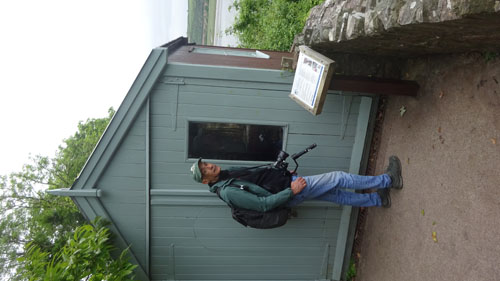 was
at the time Thomas wrote there. Famous is his Poem in October, written
on the occasion of his 30th birthday, in which he describes what he saw
on that day on a walk along the coast and harbor of Laugharne. The walk
is signposted. We have coffee in a café run by three quirky but
inefficient elderly ladies.
was
at the time Thomas wrote there. Famous is his Poem in October, written
on the occasion of his 30th birthday, in which he describes what he saw
on that day on a walk along the coast and harbor of Laugharne. The walk
is signposted. We have coffee in a café run by three quirky but
inefficient elderly ladies.
We drive past St Martin's Church, where Dylan and his wife Caitlin are
buried under one simple white cross with their names on either side.
Thomas died at the age of 39, while on a lecture tour of the U.S. from
poorly treated pneumonia.
We drive to Tenby, a seaside town further west. It is an old
fortified town, first mentioned in the 9th century. The Normans took it
and fortified it. In the Middle Ages it experienced prosperity, which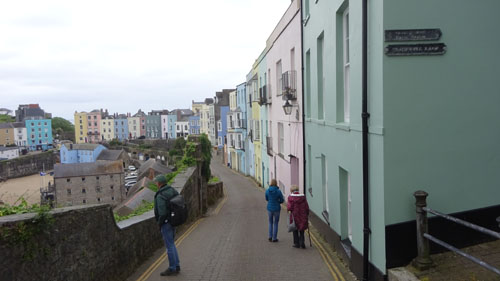 again decayed, but with the coming of the railroad in 1863 it revived as
a vacation destination. That is still noticeable today. The town thrives
on tourism. Lots of restaurants, souvenir stores and stores with beach
gear.
again decayed, but with the coming of the railroad in 1863 it revived as
a vacation destination. That is still noticeable today. The town thrives
on tourism. Lots of restaurants, souvenir stores and stores with beach
gear.
The view of the sea and the harbor is beautiful and the quays along the harbor look colorful. The beaches either side of the harbor are wide, especially at low tide at the time we are there. We have lunch at Café Vista on the edge of the cliff overlooking the beach. We stroll the streets, check out the church and the city wall, do some shopping and then drive back to our Airbnb.
Erik cooks another simple, yet tasty meal tonight.
Weather: Weather: cloudy and chilly, 14 degrees.
Friday 24 May 2024
Today we drive to St David's, on the coast, where the cathedral stands,
founded by the patron saint of Wales, St David (±500-±589). It is the
smallest town in the UK with a population of over 1,700. It was granted
city rights in the 12th century, but lost them in 1886. They were
restored in 1994 at the request of Queen Elizabeth II. The cathedral
stands on the site where St David founded 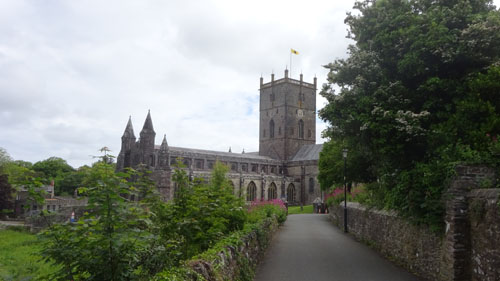 a church on the banks of the
River Alun in the mid-6th century. From the Middle Ages, St David's
became an important place of pilgrimage. In the Norman period, the
cathedral was rebuilt. Pope Calixtus II decreed that two pilgrimages to
St David's were equivalent to one to Rome. After the Reformation in
1536, St David's deteriorated. The copper of the roof on the bishop's
palace was sold off. St David's bishop's palace is now a ruin next door
to the cathedral. After centuries of neglect, the church was renovated
in 1793 and again between 1862 and 1870.
a church on the banks of the
River Alun in the mid-6th century. From the Middle Ages, St David's
became an important place of pilgrimage. In the Norman period, the
cathedral was rebuilt. Pope Calixtus II decreed that two pilgrimages to
St David's were equivalent to one to Rome. After the Reformation in
1536, St David's deteriorated. The copper of the roof on the bishop's
palace was sold off. St David's bishop's palace is now a ruin next door
to the cathedral. After centuries of neglect, the church was renovated
in 1793 and again between 1862 and 1870.
Buried in the church is St David and an uncle of King Henry VIII. There
are beautiful stained glass windows and a beautiful altar. During our
visit there are several school classes, which are given a tour and have
to complete assignments.
We have another coffee in the center and then continue along the coast
of St Bride Bay. We stop briefly in Newgale and then drive on to the
beach town of Broadhaven. There we have lunch.
In the evening we have dinner at Hotel/Restaurant Wolfcastle (Allt yr Afon). We take the fine dining
menu and it does not disappoint. Delicious dishes, although it is a bit
much. Apparently this concept has not yet caught on in this region,
because we are the only ones tonight. The rest eat in the bistro, which
is simpler and a bit more friendly to the purse.
Weather: cloudy, occasional drizzle, but mostly dry. 14 degrees
 |
Other Travel |  |
| back | continue |